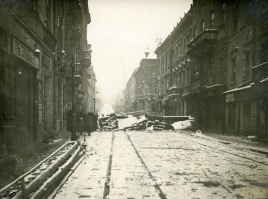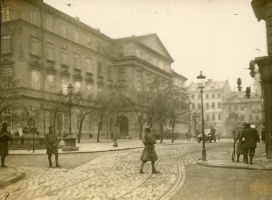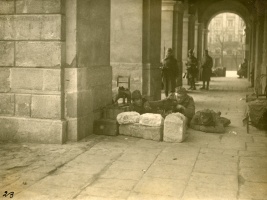Grounds for Conflict and Combatants’ Positions↑
The eastern portion of Galicia – the largest province within the Austro-Hungarian Empire – served as the principal setting for the conflict. In the countryside, ethnic Ukrainians were in the majority, whereas in Lemberg (Lviv/Lwów) and the surrounding towns they formed the minority. Before the war, ethnic Poles were the largest ethnic group in Lemberg proper; Jews comprised the second largest group, totaling more than 30 percent of city residents. Ukrainians formed the third largest group with 18 percent.
With the collapse of the Austro-Hungarian monarchy on 16 October 1918, Charles I, Emperor of Austria (1887-1922) issued a proclamation granting autonomy to nations within the Empire. Both Poles and Ukrainians accordingly began to formulate plans to take control of Eastern Galicia, with the objective of establishing national rule.
On 19 October 1918, the Ukrainian side formed a Ukrainian National Rada (Council) which announced its intention to establish an independent state on the territory of Eastern Galicia extending to the San River. On 20 October 1918, the Lemberg City Council passed a resolution to incorporate the city within the independent Polish state. The Ukrainian delegation challenged the resolution’s legality.
Street Fighting in Lemberg↑
On 1 November 1918, the Ukrainian Division – and in particular the Ukrainian Sich Riflemen – led by sotnyk (lieutenant) Dmytro Vitovskyi (1887-1919), attacked the Polish side and took control of key facilities within the city. Lemberg was declared the capital of the newly established ZUNR. In response, Poles established two bases of resistance headed by the Lemberg Central Defense Unit under Czesław Mączyński (1881-1935). The Polish combatants in the battles for control of Lemberg included a significant number of youth.
The struggle for Lemberg lasted until 21 November 1918. Superior Polish numbers and firepower from nearby Przemyśl allowed them to drive the Ukrainian forces from the city on 22 November 1918. The capture of the city unleashed a two-day pogrom in both Jewish and Ukrainian districts.
Battles in Eastern Galicia↑
By mid-December 1918, the Polish-Ukrainian battlefront extended from Tisna to Khyriv and farther along the Przemyśl – Lemberg railway line to Yaroslav through Liubachiv, Rava-Ruska, Bełz and Krylov in the Chełm land.
The so-called Polish “East Army” was assembled in mid-November 1918 under the leadership of Tadeusz Rozwadowski (1886-1928). The Ukrainians countered with forces from the Ukrainian Galician Army (UGA), the ZUNR’s regular army. In early January 1919, Polish forces secured a marked advantage, taking the towns of Bełz and Uhnów, as well as the Yaroslav - Rava-Ruska railway line. Immediately after being ousted from Lemberg, the Ukrainian Galician Army attempted - in vain - to retake the city and drive Polish forces back beyond the San River.
Following those unsuccessful attempts, the Ukrainian forces launched what is known as the Vovchukhy Offensive (16-23 February 1919), which severed railway connections between Przemyśl and Lemberg. It was a felicitous turn of events for the Ukrainians; following a request from the Entente Mission, hostilities were temporarily suspended.
Hostilities resumed on 2 March 1919. By 19 March 1919, Polish forces had retaken the Przemyśl – Lemberg railway line. The 35,000-strong French Haller Army’s arrival at the front gave the Poles an even greater advantage. As April 1919 drew to a close, the Poles prepared for a restructured offensive on Eastern Galicia. The attack started in mid-May 1919 and Poles captured part of Eastern Galicia. The Romanian army launched an offensive in the southwestern sector of Eastern Galicia at the same time, capturing the Pokuttia region.
The bulk of the Ukrainian forces were now stationed in southeastern Galicia, between the Zbruch and Dniester rivers. Here the army was restructured under the leadership of General Oleksandr Hrekov (1875-1958), who devised a counteroffensive known as the Chortkiv Offensive (7-28 June 1919). In fierce fighting, the Ukrainians managed to drive the Polish forces beyond the line of the Dniester and Hnyla Lypa rivers. However, the UGA’s gains were soon lost, their forces driven back between the Dniester and Zbruch rivers. On 28 June 1919, Polish soldiers broke through the Ukrainian line, and by 16 July 1919 they had forced the UGA to retreat back across the Zbruch onto the territory of the Ukrainian National Republic.
Short- and Long-Term Consequences of the Conflict↑
From that point on, Polish forces occupied the territory of Eastern Galicia. The Entente Council of Ambassadors formalized the final declaration annexing Eastern Galicia to Poland on 15 March 1923.
The conflict and its memorialization played a significant role in interwar Poland. In the 1920s, the Polish government erected a memorial at Lwów’s Lychakiv Cemetery dedicated to the Polish forces that had fought in the city’s defense. However, the memorial was destroyed in the Soviet period. In the late 1980s, efforts to restore the memorial were undertaken, provoking heated Polish-Ukrainian discussions that lasted into the early 2000s. In 2005, the Ukrainian-Polish debate was regulated on the state level in both countries. It was decided that a Ukrainian memorial would be erected near the Polish memorial. The official unveiling took place on 24 June 2005 with the Polish and Ukrainian presidents in attendance.
A War of Memories↑
The Polish-Ukrainian War of 1918-19 remains a battleground of varying interpretations and conflicting narratives. In the Polish cultural recollection of the war’s events, the central position is given to the Battle of Lemberg that took place between 1 and 22 November 1918. It is referred to in Polish historiography as “the Defense of Lwów.” During the Second Polish Republic, the “Youth Hero Cult” of those who fought to defend the city, the so-called Lwów Eaglets (Orlęta lwowskie), arose. The Ukrainian narrative in turn is centered around 1 November 1918, the date of the declaration of the West Ukrainian National Republic and the acquisition of power in Lviv.
Oksana Dudko, Center for Urban History of East Central Europe
Section Editor: Piotr Szlanta
Selected Bibliography
- Klimecki, Michał: Polsko-ukraińska wojna o Lwów i Galicję Wschodnią 1918-1919 (Polish-Ukrainian War for Lwów and Eastern Galicia 1918–1919), Warsaw 2000: Oficyna Wydawnicza Volumen.
- Szporluk, Roman: Polish–Ukrainian relations in 1918. Notes for discussion, in: Latawski, Paul (ed.): The reconstruction of Poland, 1914–1923, London 1992, pp. 41–54.
- Ther, Philipp; Czaplicka, John: War versus peace. Interethnic relations in Lviv during the first half of the twentieth century, in: Harvard Ukrainian Studies 24, 2000, pp. 251-284.
- Zashkilnyak, Leonid: Do genezy ukrainsko-polskogo konfliktu u XX stolitti (To the roots of the Ukrainian-Polish conflict in the 20th century): Ukraine – Poland. Istorychna spadschyna i suspilna svidomist, volume 3–4, 2011, pp. 22-41.
- Zhurzhenko, Tatiana: The border as pain and remedy. Commemorating the Polish–Ukrainian conflict of 1918–1919 in Lviv and Przemyśl, in: Nationalities Papers. The Journal of Nationalism and Ethnicity, 2013, pp. 1-27.













